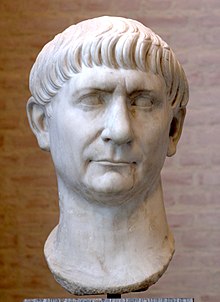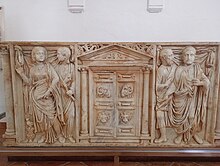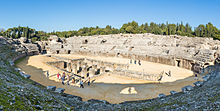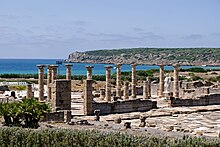List of Roman governors of Hispania Baetica
| Provincia Hispania Baetica | |||||||||
|---|---|---|---|---|---|---|---|---|---|
| Province of the Roman Empire | |||||||||
| 14 BC – 5th century | |||||||||
 The Roman province of Hispania Baetica, c. 125 AD | |||||||||
| Capital | Corduba | ||||||||
| Area | |||||||||
| • Coordinates | 37°30′00″N 6°00′00″W / 37.5000°N 6.0000°W | ||||||||
| Historical era | Antiquity | ||||||||
• Established | 14 BC | ||||||||
• Visigothic conquest | 5th century | ||||||||
| |||||||||





Hispania Baetica, often abbreviated Baetica, was one of three Roman provinces created in Hispania (the Iberian Peninsula) on 27 BC. Baetica was bordered to the west by Lusitania, and to the northeast by Tarraconensis. Baetica remained one of the basic divisions of Hispania under the Visigoths. Its territory approximately corresponds to modern Andalusia.
Name
In Latin, Baetica is an adjectival form of Baetis, the Roman name for the Guadalquivir River, whose fertile valley formed one of the most important parts of the province.
History

Before Romanization, the mountainous area that was to become Baetica was occupied by several settled Iberian tribal groups. Celtic influence was not as strong as it was in the Celtiberian north. According to the geographer Claudius Ptolemy, the indigenes were the powerful Turdetani, in the valley of the Guadalquivir in the west, bordering on Lusitania, and the partly Hellenized Turduli with their city Baelo, in the hinterland behind the coastal Phoenician trading colonies, whose Punic inhabitants Ptolemy termed the "Bastuli". Phoenician Gadir (Cadiz) was on an island against the coast of Hispania Baetica. Other important Iberians were the Bastetani, who occupied the Almería and mountainous Granada regions. Towards the southeast, Punic influence spread from the Carthaginian cities on the coast: New Carthage (Roman Carthago Nova, modern Cartagena), Abdera and Malaca (Málaga).

Some of the Iberian cities retained their pre-Indo-European names in Baetica throughout the Roman era. Granada was called Eliberri, Illiberis and Illiber by the Romans; in Basque, "iri-berri" or "ili-berri", still signifies "new town".[citation needed]


The south of the Iberian peninsula was agriculturally rich, providing for export of wine, olive oil and the fermented fish sauce called garum that were staples of the Mediterranean diet, and its products formed part of the western Mediterranean trade economy even before it submitted to Rome in 206 BC. After the defeat of Carthage in the Second Punic War, which found its casus belli on the coast of Baetica at Saguntum, Hispania was significantly Romanized in the course of the 2nd century BC, following the uprising initiated by the Turdetani in 197. The central and north-eastern Celtiberians soon followed suit. It took Cato the Elder, who became consul in 195 BC and was given the command of the whole peninsula to put down the rebellion in the northeast and the lower Ebro valley. He then marched southwards and put down a revolt by the Turdetani. Cato returned to Rome in 194, leaving two praetors in charge of the two Iberian provinces. In the late Roman Republic, Hispania remained divided like Gaul into a "Nearer" and a "Farther" province, as experienced marching overland from Gaul: Hispania Citerior (the Ebro region), and Ulterior (the Guadalquivir region). The battles in Hispania during the 1st century BC were largely confined to the north.
In the reorganization of the Empire in 14 BC, Baetica was made a senatorial province, which means it was governed by a proconsul who had formerly been a praetor appointed by the Senate. Its capital was Colonia Patricia Corduba (modern day Córdoba), founded in 169 BC. Fortune smiled on rich Baetica, which was Baetica Felix, and a dynamic, upwardly-mobile social and economic middling stratum developed there, which absorbed freed slaves and far outnumbered the rich elite. The Senatorial province of Baetica became so secure that no Roman legion was required to be permanently stationed there, whereas Legio VII Gemina was permanently stationed to the north, in Hispania Tarraconensis, in a camp which later became the city of León.



Baetica was divided into four conventūs, which were territorial divisions like judicial circuits, where the chief men met together at major centers, at fixed times of year, under the eye of the proconsul, to oversee the administration of justice: the conventus Gaditanus (of Gades, or Cádiz), Cordubensis (of Cordoba), Astigitanus (of Astigi, or Écija), and Hispalensis (of Hispalis, or Seville). As the towns became the permanent seats of standing courts during the later Empire, the conventūs were superseded (Justinian's Code, i.40.6) and the term conventus is lastly applied to certain bodies of Roman citizens living in a province, forming a sort of enfranchised corporation, and representing the Roman people in their district as a kind of gentry; and it was from among these that proconsuls generally took their assistants. So in spite of some social upsets, as when Septimius Severus put to death a number of leading Baetians— including women — the elite in Baetica remained a stable class for centuries.

Columella, who wrote a twelve volume treatise on all aspects of Roman farming and knew viticulture, came from Gades (Cádiz). The vast olive plantations of Baetica shipped olive oil from the coastal ports by sea to supply Roman legions in Germania and general demand elsewhere in the empire. Amphoras from Baetica have been found everywhere in the Western Roman empire. It was to keep Roman legions supplied by sea routes that the Empire needed to control the distant coasts of Lusitania and the northern Atlantic coast of Hispania.

Baetica was rich and strongly Romanized, attracting colonists and merchants from Italy. Since the 1st century BC it produced outstanding figures like the aforementioned Columella, the rhetorician Seneca the Elder, his son the estoic philosopher Seneca the Younger, and Lucan, author of the epic poem Pharsalia on Caesar's civil war against Pompey the Great. The last three were members of the Annaea family, a prominent Roman gens settled in Córdoba. Facts that the Emperor Vespasian was rewarding when he granted the Ius latii that extended the rights pertaining to Roman citizenship (latinitas) to the inhabitants of Hispania, an honor that secured the loyalty of the Baetian elite and its middle class.
Baetica also gave Rome two emperors. Trajan, the first emperor since Claudius to be of provincial birth, though of Italic stock, was born in Itálica (Baetica), a colony established in 206 BC by Scipio Africanus for Roman veterans of the Second Punic War.[1] Trajan's kinsman and successor Hadrian also came from Itálica. Marcus Aurelius, though born in Rome, had ancestors born in the town of Ucubi (modern day Espejo), a Roman colony not far from Córdoba.
Baetica enjoyed Pax Romana for most of imperial history, though it faced a permanent threat stemming from Africa from the 2nd century AD. On 171 groups of mauri (natives of Mauretania Tingitana, roughly modern day Morocco) crossed the Strait of Gibraltar and looted rural towns for months until they were expelled. A century later, in 296–297, Emperor Maximian built a massive palace nearby Córdoba from where to command the campaign against piracy in the Strait and Berber incursions in Mauritania.
Baetica was Roman until the brief invasion of the Vandals and Alans passed through in the 5th century, followed by the more permanent kingdom of the Visigoths. The province formed part of the Exarchate of Africa and was joined to Mauretania Tingitana after Belisarius' reconquest of Africa. The Catholic bishops of Baetica, solidly backed by their local population, were able to convert the Arian Visigoth king Reccared and his nobles. As an administrative unit, Baetica ceased to exist after the Islamic invasion in 711.
Proconsuls

The Province was governed by a proconsul who had formerly been a praetor.
| Proconsuls | Term Start | Term End |
|---|---|---|
| Gaius Vibius Serenus[2] | 20 AD | 22 AD |
| Gaius Caetronius Miccio | c. 37 AD | c. 38 AD |
| Umbonĭus Silĭo[3] | 43 AD | 44 AD |
| Marcus Ulpius Traianus[4] | ? | Before 67 AD |
| Lucius Lucullus[5] | 70s AD | 70s AD |
| [? Marcus] Sempronius Fuscus[6] | 78 AD | 79 AD |
| Gaius Cornelius Gallicanus | 79 AD | 80 AD |
| Lucius Antistius Rusticus | 83 AD | 84 AD |
| Baebius Massa | 91 AD | 92 AD |
| Galeo Tettienus Severus Marcus Eppuleius Proculus Tiberius Caepio Hispo | 95 AD | 96 AD |
| ? Gallus | 96 AD | 97 AD |
| Gaius Caecilius Classicus | 97 AD | 98 AD |
| Quintus Baebius Macer | 100 AD | 101 AD |
| Instanius Rufus | 101 AD | 102 AD |
| ? Lustricius Bruttianus | Before 107 AD | Before 107 AD |
| [? Titus] Calestrius Tiro | 107 AD | 108 AD |
| Egnatius Taurinus | between 138 AD and 143 AD | between 138 AD and 143 AD |
| ? Gaius Julius Proculus | 122 AD | 123 AD |
| Publius Tullius Varro | 123 AD | 124 AD |
| Lucius Flavius Arrianus | before 129 AD | before 129 AD |
| Gaius Javolenus Calvinus[7] | between 138 AD and 143 AD | between 138 AD and 143 AD |
| Aelius Marcianus | between 138 AD and 161 AD | between 138 AD and 161 AD |
| Publius Statius Paullus Postumus Junior | middle of the 2nd century | middle of the 2nd century |
| Publius Cornelius Anullinus | 170 AD | 171 AD |
| Gaius Aufidius Victorinus | 171 AD | 171 AD |
| Gaius Memmius Fidus Julius Albius[8] | 183 AD | 183 AD |
| Caecilius Aemilianus[8] | 215 AD | 215 AD |
| Aulus Caecina Tacitus[9] | first half 3rd century | first half 3rd century |
| L. Sempronius O[...] Celsus [Servi]lius Fabianus[10] | first half 3rd century | first half 3rd century |
| Quintus Pomponius Munat[ianus?] Clodianus[11] | first half 3rd century | first half 3rd century |
See also
References
Citations
- ^ Arnold Blumberg, "Great Leaders, Great Tyrants? Contemporary Views of World Rulers who Made History", 1995, Greenwood Publishing Group, p.315
- ^ Tacitus, Annales iv.13
- ^ Dio Cassius, 60.21.5
- ^ Paul Leunissen, "Direct Promotions from Proconsul to Consul under the Principate", Zeitschrift für Papyrologie und Epigraphik, 89 (1991), p. 236
- ^ Pliny the Elder, Naturalis Historia 9.48
- ^ Unless otherwise noted, governors from 78/79 to 136/137 are taken from Werner Eck, "Jahres- und Provinzialfasten der senatorischen Statthalter von 69/70 bis 138/139", Chiron, 12 (1982), pp. 281–362; 13 (1983), pp. 147–237.
- ^ Unless otherwise noted, the governors from 138 through 180 are taken from Géza Alföldy, Konsulat und Senatorenstand unter der Antoninen (Bonn: Rudolf Habelt Verlag, 1977), pp. 262f
- ^ a b Paul M. M. Leunissen, Konsuln und Konsulare in der Zeit von Commodus bis Severus Alexander (1989) p. 297
- ^ Leunissen, "Direct promotions", p. 249
- ^ CIL VI, 15113
- ^ Leunissen, "Direct promotions", pp. 249f
Bibliography
- García, Carmen Castillo (1968). Prosopographia Baetica [Collective Biographies of Baetica] (in Spanish). Universidad de Navarra.
- Castillo, Carmen (1975). Städte und Personen der Baetica [Settlements in Baetica] (in German). de Gruyter.
- A. T. Fear, Rome and Baetica: Urbanization in Southern Spain, C. 50 BC – AD 150 in the series "Oxford Classical Monographs".
- Evan Haley, Baetica Felix: People and Prosperity in Southern Spain from Caesar to Septimius Severus, (excerpt from the Introduction).
- El Housin Helal Ouriachen, 2009, La ciudad bética durante la Antigüedad Tardía. Persistencias y mutaciones locales en relación con la realidad urbana del Mediterraneo y del Atlántico, Tesis doctoral, Universidad de Granada, Granada.
